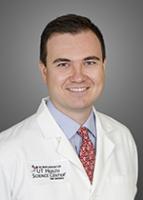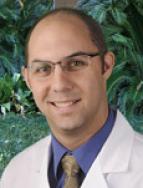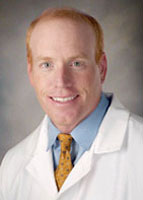|
June is Men's Health Month
“The body is the car the brain gets to drive around in. To maintain your vehicle, you’ve got to check the tires, change the oil and fix what’s broken before it gets worse.” For the last five years, Dr. Alexander Shepherd, a board-certified clinical pharmacologist and internist, has been leading the Men’s Comprehensive Health Institute at UT Health.
“The body is the car the brain gets to drive around in. To maintain your vehicle, you’ve got to check the tires, change the oil and fix what’s broken before it gets worse.” For the last five years, Dr. Alexander Shepherd, a board-certified clinical pharmacologist and internist, has been leading the Men’s Comprehensive Health Institute at UT Health. He’s been caring for male patients for more than 40 years and says it didn’t take long for him to notice a pattern. “When men are young, they are more active, they are stronger and less stressed. But once they get married and have children, they begin focusing on caring for their family—and less for themselves.” Here is the five-point inspection plan Dr. Shepherd shares with his patients to help them stay as healthy as possible. Most can be accomplished by simply scheduling a preventive check-up every year—which is the foundation of the Men’s Comprehensive Health Institute.
1. Maintain a healthy blood pressure Busy lives leave less time for exercise and healthy cooking, which, when combined, can lead to weight gain. Being overweight can lead to high blood pressure, a major risk factor for developing heart disease. High blood pressure is usually asymptomatic, which means many men have high blood pressure without any symptoms. Check your blood pressure at least twice a year. If you get a high reading (over 125/85) continue checking it 2-3 times a week for an entire month. Every time you check your blood pressure, repeat the process 3 times, waiting 1-2 minutes between each reading. Then, write down the average of the second and third readings. This will provide the truest measure of your blood pressure. If that average is consistently over 125/85, make an appointment with a primary care provider.
2. Watch your blood sugar levels “Our primitive brain loves to eat, and it wants us to put on as much weight as possible to prepare us for times of famine,” Dr. Shepherd warns. But being overweight can make you resistant to your own insulin. This resistance signals the pancreas to begin creating more and more insulin, until it can’t produce any more, and that’s when diabetes develops. Dr. Shepherd recommends receiving a hemoglobin A1c test every year to check the amount of sugar in your blood. Your A1c results determine if you are at risk for developing diabetes. Even if you are not at risk, Dr. Shepherd suggests working to get down to a healthy weight for your age, height and frame. Exercise and a healthy diet, like the Mediterranean Diet, is a great place to start.
3. Control your cholesterol
Somewhat related to your diet is the level of cholesterol in your blood, although current studies have shown that genetics play a large role. Many men have high cholesterol and are not aware of it, which can lead to higher risks of having a cardiac event such as a heart attack.
The goal is to have lower bad cholesterol (LDL) and higher good cholesterol (HDL).
Even those with a family history of high cholesterol can do their part to overcome genetics. To raise your level of good cholesterol (HDL), start a 30 minute exercise routine that you’ll enjoy doing at least three times every week. To lower your level of bad cholesterol (LDL) begin eating a healthy diet and maintain a healthy weight for your age, height and frame.
4. Stay in shape
Regular exercise paired with a good diet can help you maintain your health in more ways than we could list here. Luckily, Dr. Shepherd says you don’t have to spend hours in the “grunt” section of the gym to reap the benefits. Instead, you should develop a weekly cross-circuit program that’s easy for you to maintain and includes: - Aerobic/cardio: Three days a week, complete 30 minutes of low impact cardio (elliptical, bike, swim). Get your heart rate up to the optimal 130 beats per minute and try to keep it there throughout the workout.
- Muscle strength: Develop a weightlifting circuit that strengthens all of your large muscle groups. Focus on using low weights and doing a lot of reps. Do this circuit three times a week.
- Stretching: Stay limber by stretching after every workout. Find stretches that stretch your hips, shoulders and back. Dr. Shepherd recommends learning some Pilates stretches and using them as regularly as possible.
5. Stress less and exercise your brain
Good brain health is a major factor in maintaining your total health. “Brains are like biceps,” Dr. Shepherd says,. “Use them or lose them.” What men do to keep their brain healthy varies from man to man. For instance, some men never worry, while others are constantly stressed. The main tip Dr. Shepherd offers is “get enough sleep and use your vacation days. Make the time to do things you enjoy. Go fishing or take a trip.” And if you are dealing with a problem you can’t seem to solve on your own, find a therapist or counselor who can help talk you through it.
If you’re retired or live alone, don’t stop learning. Keep your brain active by maintaining your current hobbies. And consider taking up something brand new. It’s never too late.
The Men’s Comprehensive Health Institute is able to schedule all of a man's necessary annual and preventive exams during a single visit at a single location. Your appointment will be tailored to only include exams, tests and specialists you need according to your age and specific health concerns.
Click here for more information on our website, or call 210-450-6400 for an appointment.
 |
|
 |  |
|
What is a cataract?
Having trouble seeing? Have blurry or cloudy vision? If you're over 60, this is probably a cataract. Younger people get them, too, but they're more common in older adults.
Are you having trouble seeing? Is your vision blurry or cloudy? If you're over 60, you probably have a cataract. Younger people get them, too, but they're more common in older adults. A cataract is where the lens of the eye becomes cloudy and makes vision blurry. It is typically caused by a change in the proteins of the lens. The lens in your eye works just like the lens in a camera, focusing light on the back wall (called the retina) for clear vision. A cataract blocks and bends some of the light which changes the ability to focus.
Cataracts can cause everything from slight blurriness and near-sightedness to double vision, trouble seeing at night or even blindness. The good news is that your eye doctor has many different tools for treating cataracts, and chances are good for restoring your vision.
Besides aging, cataracts can be caused by genetics (some babies are born with cataracts), as well as other medical conditions such as diabetes or exposure to toxins. There can be many different causes, but aging is the most common. Smoking, air pollution and heavy drinking can also increase your chances of getting cataracts.
Cataracts are easy for your eye doctor to diagnose. The doctor will dilate your eyes and do an exam that may include taking pictures of your eyes. Glasses or contacts can correct your vision with cataracts, but if it gets worse, your doctor may recommend cataract surgery.
Cataract surgery is now the most common surgery performed by eye surgeons. It is estimated that nearly 4 million Americans have cataract surgery each year.
Cataract surgery is done on an outpatient basis, meaning you will go home the same day. The surgeon will remove your natural lens and replace it with an artificial lens that matches your natural vision.
According to the National Eye Institute, more than 90 percent of patients who get cataract surgery say they can see better afterward.
If you are having trouble seeing clearly, or suspect you may have cataracts, call UT Health Ophthalmology for an appointment at 210-450-9400.
Learn more about cataracts on our website by clicking here.
 |  |
Men's Health Update: Benign prostate hyperplasty
Benign prostate hyperplasty, commonly known as BPH can mean many things. Learn more about this condition and how it affects men in all stages of life on the new UT Health website health library.
Keep your skin healthy this summer
One of our board-certified dermatologists shares her expert tips on how to enjoy the summer while saving your skin, hair and nails from summer sun and heat.
Sunburns: Avoiding them and treating them
Blistering sunburns don’t just put a damper on your fun in the sun, they also increase your risk of developing skin cancers, including melanoma. All shades of skin are at risk for sunburns, although it is more common in individuals with fair skin and light eye color, so do your best to avoid sunburns by applying a sunscreen to all exposed areas, with 30 SPF or higher every day prior to sun exposure. Avoid spending long periods outdoors during the sunniest time of day, between 10:00 a.m. and 2:00 p.m.
When you plan to spend extended time outdoors, slather on sunscreen 20-30 minutes before heading out. Use a broad-spectrum, water-resistant sunscreen that is thicker than your daily-wear product. Make sure you cover all skin that may become exposed to the sun, including your ears and lips. Reapply every 2 hours while out in the sun, and after swimming or sweating. Adding a wide-brimmed hat or parasol to your ensemble can further protect you from a burn. Sun-protective clothing is available and can also increase your protection.
Avoid tanning in the sun or in salons. Instead, opt for a tanning lotion, gel or mist. Be sure to do a test spot before applying it over your entire body.
If you do get sunburned, go inside, take a cool shower and apply cool washcloths to the burned area. Cooling gels or creams with aloe vera can also help. You can apply hydrocortisone cream to the reddened areas and take ibuprofen (if you are able) to help with inflammation and pain. See a dermatologist if these measures don’t improve your symptoms.
Preventing skin cancer: Schedule your free screening
You should look at your skin every 3 months in front of a full-length mirror; checking your entire body, including your palms and soles. If you notice any new spots or changes on your skin, inform your dermatologist. Also, visit your dermatologist each year for a professional, full body skin evaluation. A board-certified dermatologist is an expert at evaluating the skin as well as diagnosing and treating skin cancers. The UT Health Cancer Center is holding a free skin screening event Thursday, August 10. Register here for the free screening.
If you do find a spot or mole that looks concerning, call your dermatologist for an appointment. Click here to learn how skin cancer looks, symptoms and treatment.
More summer skin saver tips:
Avoiding acne breakouts
Longer days mean more time for fun under the sun. It also means more sweat, and sweat can contribute to breakouts on your face and body. That's why you should be sure to shower after sweating and always wash your active clothes before wearing them again. You can also consider changing your skin care routine. Use less product overall, and avoid alcohol-based products which could irritate your skin and cause an acne flare-up.
Always wear your sunscreen, but limit everything else you put on your skin. A dermatologist can recommend a healthy skin care routine tailored for your specific skin. Choose products that are oil-free and non-comedogenic. They are less likely to clog your pores.
If you do notice that you're breaking out, wash with a cleanser containing salicylic acid or benzoyl peroxide (be careful, as this ingredient can bleach clothing). If the situation doesn't improve, schedule an appointment with a dermatologist for a more advanced care program.
Bug bites
Protect yourself from summer’s pests by using bug repellent products like sprays, bands or candles. If you find yourself bitten or stung, apply hydrocortisone cream to the area and take an antihistamine, such as cetirizine (Zyrtec), loratadine (Claritin), fexofenadine (Allegra) to help ease the allergic reaction. Benadryl is also helpful, especially before bedtime, because it can make you drowsy. Avoid topical Benadryl creams because it can cause some people, to develop a rash, i.e. contact dermatitis. If bites or stings are very bothersome or become infected, schedule an appointment with a dermatologist. If you experience extreme swelling, vision or breathing problems, immediately seek emergency care.
Nail Care
Warmer weather is prime time for showing off those toes. But the sun's UV rays and time spent in water can wreak havoc on your nails. Always keep your toenails dry, clean and trimmed.
Chlorine and saltwater tend to make nails more brittle. If you’re spending a lot of time in the water, be sure to dry your feet quickly and completely. Use cuticle oils and moisturizers to keep your nails hydrated. Keeping your feet dry and wearing sandals or flip flops in wet public areas will also decrease your risk of developing fungal infections like athlete's foot or plantar warts.
Those who wear nail polish should be sure to apply a double base coat as the sun's UV rays can “bake” polish into your nails and cause discoloration. If you enjoy professional manicures or pedicures, consider bringing your own tools and products to avoid fungal or bacterial infections. Also, avoid shaving those areas within 24 hours before and after receiving your service to decrease your risk of infection. If you notice a nail or foot concern, take care of it right away and consult a dermatologist.
Hair Care
The sun’s heat and UV rays can have a major impact on the health of your hair. While some conditions, like dandruff, may get better during these more humid months, other problems can arise. Folliculitis is a common condition, which can occur on the scalp or the rest of the body, is caused by clogged hair follicles. Its symptoms include red, sensitive or itchy bumps on the skin. Ward it off by wearing light, loose clothing and changing out of sweaty, tight clothing as soon as possible.
During summer, hair can become dry, brittle or discolored due to time spent under the sun and in the water. Reduce the amount of heat and product you use on your hair, with the exception of a daily leave-in conditioner. Stave off damage by wearing a hat while outside and using shampoo to wash your scalp, not the length of your hair. As an added measure, use a moisturizing conditioner every time you wash to help restore moisture. When going for a swim, limit your hair’s exposure to chlorine or salt water by covering it conditioner, wearing a swim cap or wrapping it into a bun.
Rashes
Summer is the ideal time for camping, hiking and even getting some overdue yard work completed. Don't let a pesky rash stop you. Heat rash is caused by blocked sweat glands which won't allow sweat to surface, evaporate and cool the skin. It causes red, sometimes itchy, bumps on the skin. To prevent heat rash, wear lightweight, loose-fitting clothing, and try to stay as cool as possible. Work during the coolest parts of the day, with a fan or mister nearby, and cool off with a refreshing shower afterward.
Other itchy culprits are plant-based rashes caused by poison oak, ivy and sumac. Learn how to identify and avoid these poisonous plants. If you do come into contact, take a cool shower, and wash your clothing as soon as possible. If the rash is mild, you can apply hydrocortisone cream to the affected areas and take an antihistamine to help treat symptoms. If the reaction is more severe, visit your primary care doctor or dermatologist for treatment.
Dry, Itchy Skin
The strong summer sun and time in the water can make your skin dry and itchy. Keep your whole body hydrated by drinking at least 64 ounces of water each day and eating water-rich foods like watermelon, cantaloupe and strawberries.
Keep your skin supple by showering right after you swim using cool or warm water, not hot. Moisturize with a fragrance-free, gentle moisturizer afterward. It is also a great idea to keep a travel moisturizer handy to touch-up areas on your body that are more prone to drying out.
These tips provided by board-certified dermatology and dermatopathology specialist, Dr. Adaobi Nwaneshiudu of UT Health Dermatology, For more information or to make an appointment with UT Health, call 210-450-9840.
 |
|
 |  |
|
Meet your UT Health providers
Every month we introduce you to our providers at UT Health. With more than 700 primary care and specialty physicians, we have a a board-certified expert in every branch of medicine.

Christie Bialowas, M.D.
Plastic and Reconstructive Surgery

Philip Chen, M.D.
Otolaryngology (Ear, Nose and Throat)

Grant Hogue, M.D.
Orthopaedics - Children's Spine, Hips

Philip Jacobs, M.D.
Orthopaedics - UT Health Hill Country

Mariana Munante, M.D.
Medical Drive Primary Care

Richard Peterson, M.D.
Bariatric and Weightloss Surgery

Randal Robinson, M.D.
Reproductive Health and Fertility

Derrick Sun, M.D.
Neurosurgery, Spine Surgery

Kent Van Sickle, M.D.
General Surgery
Scoliosis: What is it?
Scoliosis is a curvature in the back that is greater than 10 degrees. This is measured on an X-ray of the spine. As a curve develops in the spine there is also rotation and curvature of the ribs.
Scoliosis is a curvature in the back that is greater than 10 degrees. This is measured on an X-ray of the spine. As a curve develops in the spine there is also rotation and curvature of the ribs. This rotation of the ribs is what nurses and physicians routinely look for during the scoliosis screening physical examination. The most common form of scoliosis is called Adolescent Idiopathic Scoliosis, or AIS. “Idiopathic” is a fancy word that means we (physicians) don’t completely understand, yet, what causes these curves in the spine.
Curves in the back are sometimes a worrisome reality for many young people and their parents here in San Antonio. The American Association of Pediatrics and the Scoliosis Research Society have worked hand-in-hand with state legislatures, Texas included, to develop school screening programs to identify
young people with curves or rotation in the spine. In the state of Texas, school screening for scoliosis occurs during the 6th grade and again in the 9th grade. The purpose of screening is to identify young people with possible curves in their back and facilitate follow-up visits with their primary care physician or pediatric spine physician.
Who gets scoliosis?
The prevalence of the most common type of scoliosis, AIS, is around 1 percent of all adolescents. Females are 4 times more likely to have AIS than males and have a 10 times greater risk of their curvature growing. AIS is commonly diagnosed during the pre-teen and teenage growth spurts (around puberty). This can be as young as 9 years old in females or even the mid-to-late teen years for males.
How is scoliosis treated?
Scoliosis is treated in three main ways: - Very small curves (from 10 degrees to 25 degrees) are treated with close observation by a physician
- Moderate sized curves (from 25-50 degrees) are treated with a back brace
- Severe scoliosis (greater than 50 degrees) are most commonly treated with surgery to decrease the curvature and stop it from growing.
What if my child has a positive school screening or I think they have scoliosis?
The first step is to contact your child’s primary care physician or a pediatric scoliosis doctor. They can examine your child and decide if an X-ray is needed. Based on the outcome of this examination and possible X-ray, a plan can be made for observation and/or treatment.
For more information about scoliosis or our pediatric orthopaedic surgeons, call UT Health Orthopaedics at 210-450-9300.
Article provided by Grant D. Hogue, M.D., assistant professor and Chief of Pediatric Orthopaedics and Spinal Deformity at UT Health San Antonio.
 |  |
Get online with MyChart
MyChart is the secure website where UT Health patients can see the results of their lab work, make appointments and even send messages to their doctor. You can also use the MyChart app on your iPhone or Android.
|
 |  |
|
Free event at UT Health: Safer, healthier summer
Staying healthy and safe this summer is the topic of this special Texas Public Radio Think Health Science presentation on June 14. The discussion will feature three UT Health faculty members: infectious disease specialist Jason Bowling, M.D., dermatologist Sandra Osswald, M.D. and hospitalist Anthony Hartzler, M.D. The event is free and open to the public.
UT Health Research Update: Diabetes
A potential cure for Type 1 diabetes looms on the horizon at UT Health San Antonio, and the novel approach may also allow Type 2 diabetics to stop insulin shots.
Serving the Boerne area: UT Health Hill Country
Offering a wide range of services including primary care, orthopaedics and urology, UT Health Hill Country is located off the I-10 West corridor convenient to Boerne, Fair Oaks Ranch, Leon Springs and The Dominion.
|
|
|